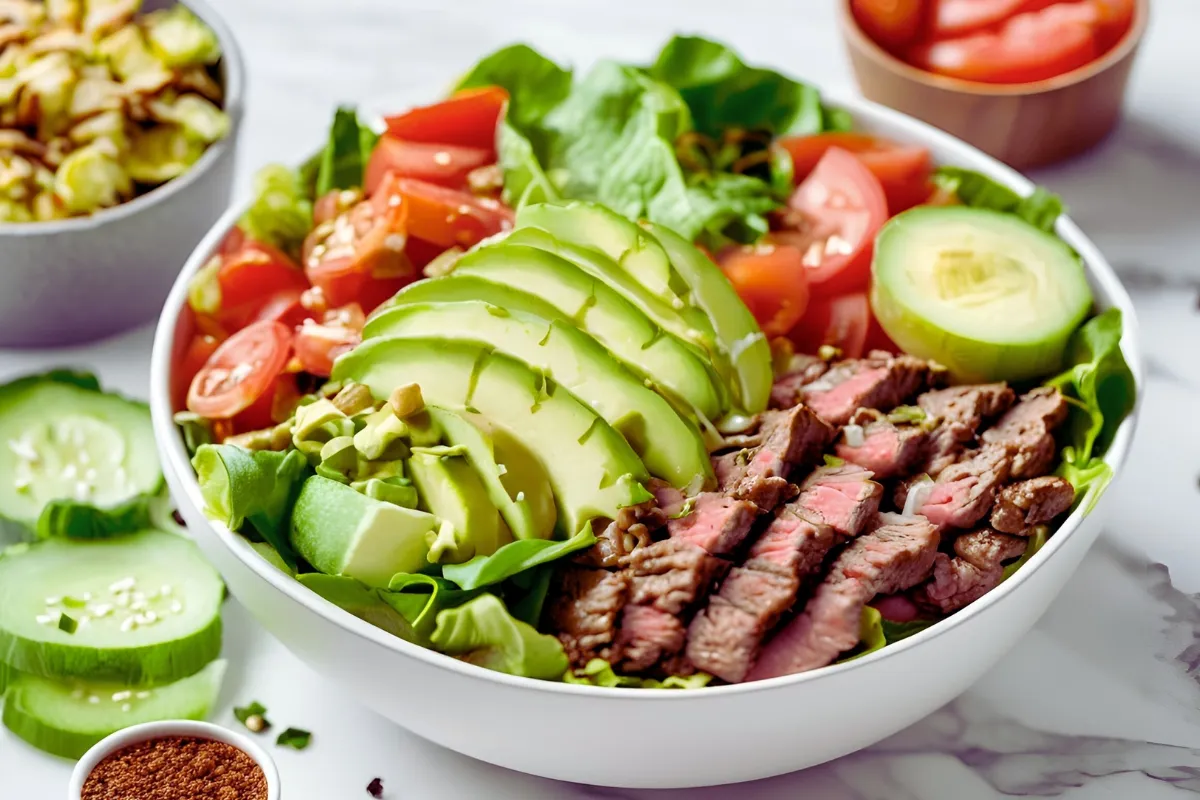Burger Bowl Recipe: A Healthy Twist on a Classic Favorite
When you think of burgers, what comes to mind? Juicy patties, melted cheese, crisp lettuce, and—of course—a fluffy bun. But what if we told you there’s a way to enjoy all that burger goodness while keeping things lighter, healthier, and dare I say, more customizable? Meet the burger bowl recipe: a deconstructed version of your favorite burger that skips the bun and lets you build a dish that’s just as satisfying—if not more so!
Whether you’re watching your carbs, trying out keto, or just looking for a fun way to jazz up dinner, the burger bowl is here to save the day. And trust me, once you’ve tried it, you’ll wonder why you didn’t ditch the bun sooner.
What is a Burger Bowl?
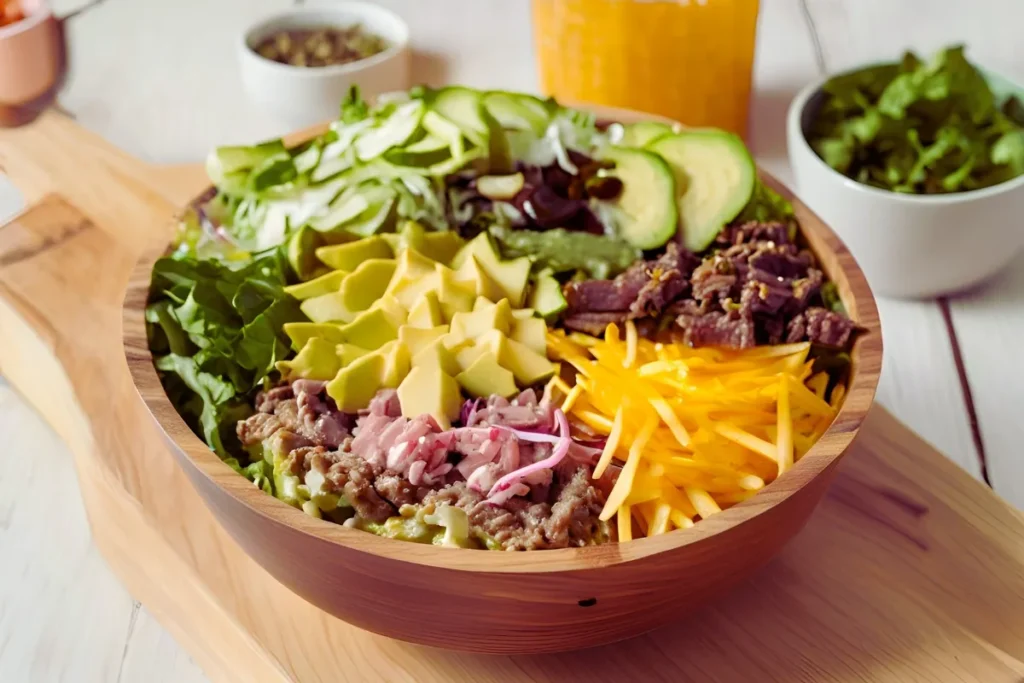
Understanding the Concept of a Deconstructed Burger
A burger bowl takes everything you love about a traditional burger and serves it up in a fresh and exciting way. Picture this: all the classic elements—like seasoned beef, fresh veggies, and your favorite toppings—artfully arranged in a bowl. No mess, no bun, and a whole lot of flavor.
Think of it as a salad-meets-burger situation, where every bite lets you experience the perfect balance of textures and tastes. It’s a dish that’s endlessly adaptable, easy to prepare, and oh-so Instagram-worthy.
Key Ingredients in a Burger Bowl Recipe
The beauty of a burger bowl lies in its simplicity and flexibility. Here’s a breakdown of the essentials:
- Protein: Ground beef, turkey, chicken, or even plant-based options like Beyond Meat.
- Veggies: Lettuce, tomatoes, onions, cucumbers, pickles—you name it.
- Toppings: Cheese, avocado, crumbled bacon, jalapeños, or sautéed mushrooms.
- Dressing: A drizzle of your favorite burger sauce, ranch, or even a light vinaigrette.
Each ingredient is layered with care to ensure every forkful is a masterpiece.
Why Choose a Burger Bowl Over a Traditional Burger?
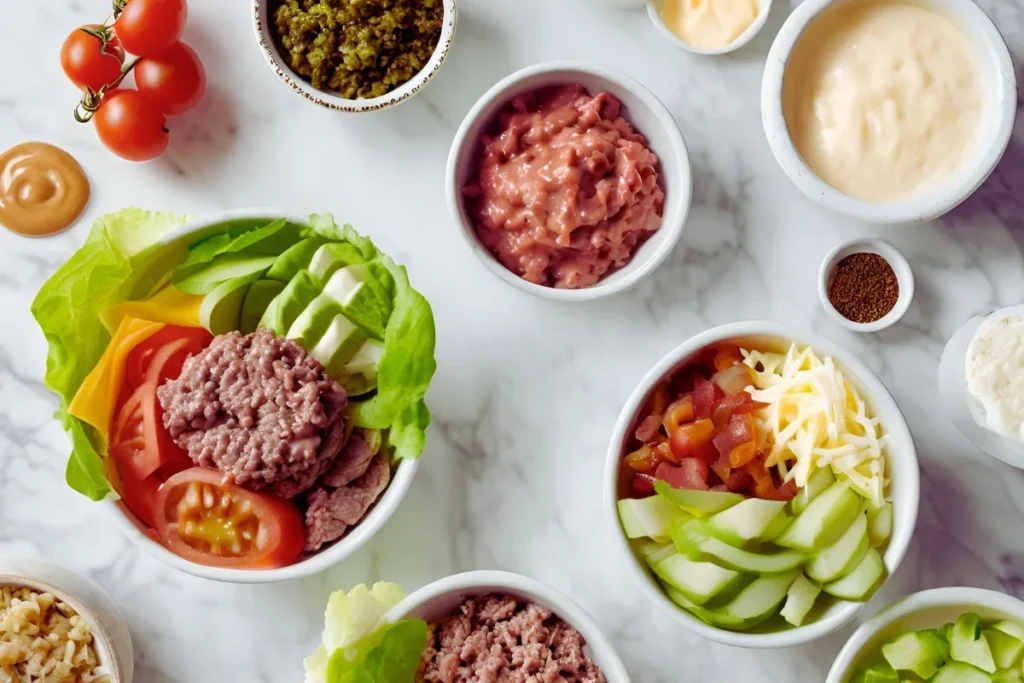
Health Benefits of a Burger Bowl
Let’s be real—burger buns can feel heavy, right? By swapping the bun for a bowl, you’re cutting down on unnecessary carbs and calories without sacrificing flavor. Plus, you’re loading up on fresh veggies and lean proteins, making it a more balanced and nutrient-dense option.
For example, a traditional cheeseburger can pack upwards of 500 calories, thanks to the bun alone. Meanwhile, a burger bowl can start as low as 300 calories, depending on your choices. This makes it perfect for those tracking their intake or aiming for a healthier lifestyle.
Customizability for Different Diets
What’s great about burger bowls is how easily they can fit into almost any diet. Keto, paleo, vegan, vegetarian—you name it. You have full control over the ingredients, so it’s easy to tailor the recipe to your needs.
- Following keto? Stick with low-carb veggies and high-fat dressings.
- Going plant-based? Opt for veggie patties and dairy-free cheese.
- Need a dairy-free option? Skip the cheese and use creamy avocado for richness.
Who Can Enjoy a Burger Bowl Recipe?
Perfect for Low-Carb and Keto Diets
Low-carb diets often mean giving up the foods you love, but burger bowls are here to prove otherwise. They’re an excellent choice for those on keto, as they combine all the fats and proteins you need while keeping carbs minimal.
Imagine a bowl with seasoned beef, shredded lettuce, diced tomatoes, and creamy avocado, all topped with a dollop of sugar-free burger sauce. Sounds like keto heaven, doesn’t it?
Family-Friendly Meal Option
Got picky eaters at home? No problem. Burger bowls are the ultimate customizable meal, making them a hit with kids and adults alike. Everyone can build their own bowl, adding the toppings they love and skipping the ones they don’t.
For busy weeknights, they’re a lifesaver. You can prep the ingredients ahead of time, set up a DIY burger bowl bar, and let everyone dig in. Plus, cleanup is a breeze—no crumbs, no soggy buns, and no complaints.
The Nutritional Profile of a Burger Bowl
How Many Calories Are in a Burger Bowl?
The calorie count of a burger bowl depends entirely on your ingredients. Typically, a burger bowl starts at around 300–400 calories for a basic version with lean ground beef, fresh veggies, and a light dressing. Add cheese, avocado, or bacon, and you’re looking at closer to 500–600 calories.
Comparison with a Traditional Burger
Here’s where burger bowls shine: a traditional cheeseburger with a bun averages 500–700 calories, with most of those coming from the bun and condiments. By ditching the bun and using healthier toppings, a burger bowl keeps the flavor intact but slashes the unnecessary calories.
Calorie Count for Popular Variations
- Classic Beef Burger Bowl: ~400 calories
- Turkey Burger Bowl with Avocado: ~450 calories
- Plant-Based Burger Bowl: ~350 calories
By tweaking the toppings and portion sizes, you can easily adjust the calorie content to fit your dietary goals.
Macronutrient Breakdown of a Burger Bowl Recipe
Protein Content Based on Burger Meat Selection
Protein is the star of the show in any burger bowl. Here’s a quick comparison of common protein options:
- Ground Beef (85% lean): ~21g protein per 3 oz.
- Ground Turkey (93% lean): ~22g protein per 3 oz.
- Plant-Based Patty: ~15–20g protein per serving.
Beef offers richness and flavor, while turkey is leaner and lighter. Plant-based options are great for vegetarians or those looking to lower their saturated fat intake.
Effect of Toppings on Nutritional Values
Toppings can make or break the nutritional profile of your burger bowl. For example:
- Adding cheddar cheese or crispy bacon boosts protein and fats but also increases calories.
- Swapping heavy sauces for a dollop of Greek yogurt-based ranch can save calories while adding creaminess.
- Opting for fresh vegetables like cucumbers or bell peppers adds crunch and nutrients with virtually no calorie impact.
Choosing the Healthiest Ingredients
What is the Healthiest Burger Meat?
Lean Beef vs. Turkey vs. Plant-Based Options
When choosing burger meat, it’s important to consider both flavor and nutrition.
- Lean Ground Beef: Rich in flavor, higher in fat (especially saturated fat). Best for those looking for a hearty taste.
- Ground Turkey: A leaner option with slightly less flavor, but pairs well with bold seasonings.
- Plant-Based Options: Lower in saturated fat, often packed with fiber, but can be highly processed—choose options with minimal additives.
Importance of Grass-Fed and Organic Meats
Grass-fed beef and organic meats are excellent choices for those focused on quality. Grass-fed beef typically has a higher omega-3 content and fewer additives compared to conventional beef. While organic options can be pricier, they ensure that the meat is free from hormones and antibiotics.
Healthiest Toppings for a Burger Bowl Recipe
Fresh Vegetables and Low-Calorie Sauces
Veggies are the backbone of a nutritious burger bowl. Popular options include:
- Crisp lettuce or spinach as a base.
- Tomatoes, onions, cucumbers, and shredded carrots for color and crunch.
- Pickles and jalapeños for a tangy kick.
For sauces, opt for low-calorie choices like mustard, light vinaigrettes, or homemade burger sauces made with Greek yogurt.
Eliminating Processed Additions
While processed cheese slices and prepackaged dressings are convenient, they often contain unhealthy additives. Instead, go for freshly grated cheese or make your own dressing to keep things clean and flavorful.
Tips for Making a Balanced and Flavorful Burger Bowl
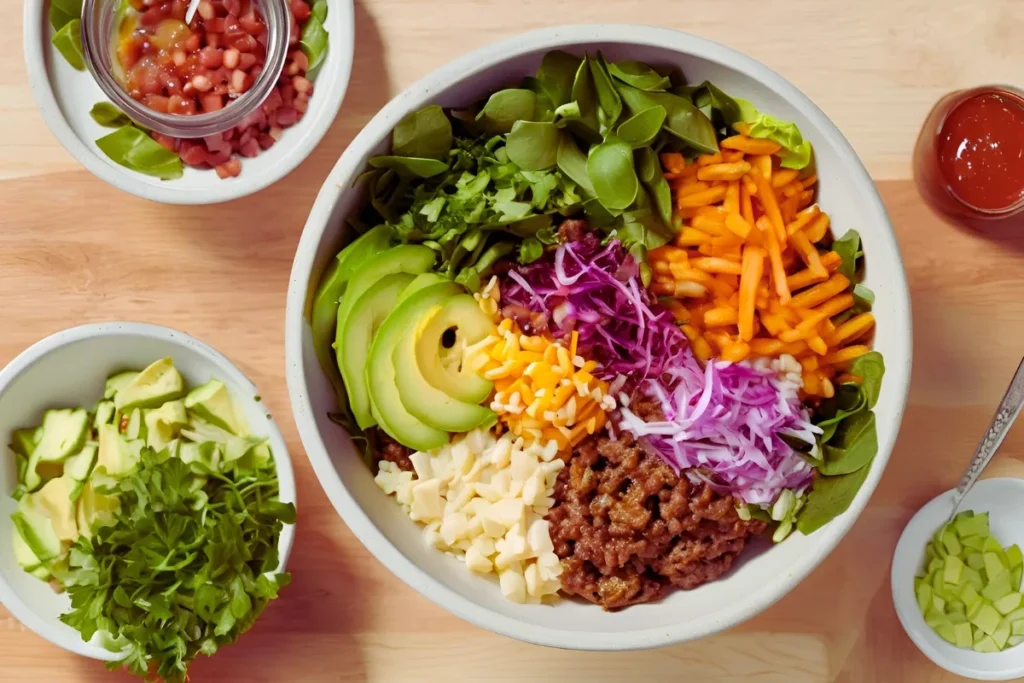
Layering Ingredients for Optimal Taste
The key to a great burger bowl is in the layering. Start with a fresh base (lettuce or spinach), add a protein layer (beef, turkey, or plant-based patty), and finish with vibrant veggies and toppings. Layering ensures every bite is balanced and flavorful.
Portion Control for Calories and Macronutrients
Keep an eye on portion sizes, especially for calorie-dense ingredients like cheese, avocado, and dressings. Use measuring tools or eyeball portions to maintain a healthy balance.
For example:
- Stick to 1 oz. of cheese (about the size of a thumb).
- Use ¼ of an avocado to keep fat intake in check.
- Limit sauces to 1–2 tablespoons.
How to Make the Perfect Burger Bowl at Home
Step-by-Step Guide to Crafting a Burger Bowl
Preparing the Protein Base
The foundation of any burger bowl is the protein. Here’s how to get it just right:
- Choose Your Protein: Lean ground beef, turkey, or a plant-based patty.
- Season Generously: Add salt, pepper, garlic powder, onion powder, and a splash of Worcestershire sauce for a flavor boost.
- Cook to Perfection: Heat a skillet over medium heat, cook patties for 3-4 minutes on each side, or until the internal temperature reaches 160°F for beef and 165°F for poultry.
For plant-based options, follow the cooking instructions on the package, but keep an eye out to avoid overcooking.
Selecting and Prepping Toppings
Burger bowls thrive on variety. Here’s how to keep it fresh:
- Wash and Chop Fresh Veggies: Romaine lettuce, cherry tomatoes, cucumbers, red onions, and bell peppers make excellent choices.
- Sauté or Roast Extras: For a warm twist, sauté mushrooms or roast zucchini slices for added texture.
- Add Flavorful Touches: Crumbled bacon, pickles, or jalapeños can take your bowl to the next level.
Creating a Healthy and Flavorful Dressing
Skip store-bought sauces filled with additives and try this easy DIY burger sauce:
- Combine 3 tablespoons of Greek yogurt, 1 teaspoon Dijon mustard, 1 teaspoon ketchup, and a dash of paprika. Mix until smooth, and voilà—creamy, tangy perfection!
Customizable Burger Bowl Variations
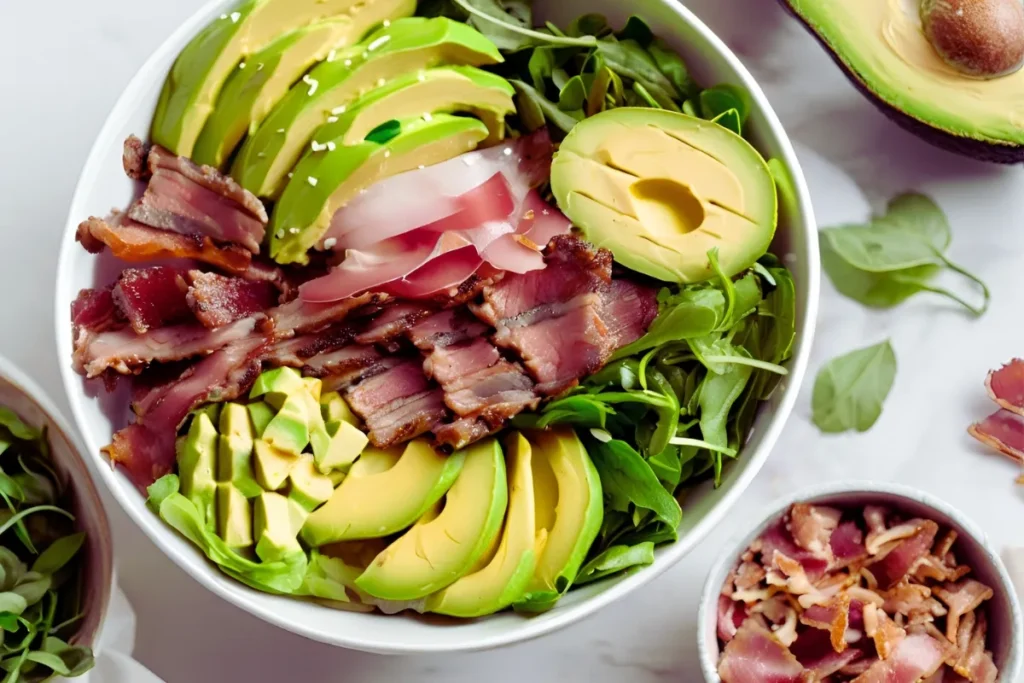
Keto-Friendly Burger Bowl
For those keeping carbs ultra-low, stick to keto-friendly ingredients:
- Base: Spinach or arugula.
- Protein: 80% lean ground beef for added fat.
- Toppings: Avocado, cheddar cheese, bacon, and sugar-free pickles.
- Sauce: A drizzle of avocado oil mayo or homemade ranch.
Vegetarian and Vegan Burger Bowl
Plant-based eaters, rejoice! A meat-free burger bowl can be just as satisfying:
- Base: Mixed greens or kale.
- Protein: Black bean or lentil patties, or marinated tofu cubes.
- Toppings: Grilled vegetables like zucchini, roasted chickpeas, and a sprinkle of nutritional yeast.
- Dressing: Tahini-based sauce or a light balsamic vinaigrette.
High-Protein Athlete’s Burger Bowl
Need a post-workout meal that’s packed with protein? Build it like this:
- Base: Quinoa or cauliflower rice.
- Protein: Double the portion of lean beef, turkey, or a high-protein veggie patty.
- Toppings: Hard-boiled eggs, low-fat cheese, and fresh veggies.
- Dressing: A protein-packed tzatziki or yogurt-based sauce.
What is the Healthiest Way to Eat a Hamburger?
Benefits of Going Bun-Free
Skipping the bun doesn’t just cut carbs—it also allows you to focus on the quality of your ingredients. Burger bowls let you savor the taste of your protein and toppings without the distraction of bread. Plus, it’s a smart way to avoid empty calories, especially for those with gluten sensitivities.
Managing Portion Sizes Without Sacrificing Flavor
Portion control is key to keeping your burger bowl healthy. Here are some simple tips:
- Use smaller plates or bowls to naturally reduce portion sizes.
- Load up on low-calorie vegetables to make your bowl feel hearty without overdoing the calorie count.
- Balance indulgent toppings (like cheese or bacon) with lighter ones (like cucumbers and tomatoes).
Summary of Key Takeaways
Balancing Nutrition and Taste in a Burger Bowl
The magic of a burger bowl lies in its ability to combine flavor and health effortlessly. By choosing high-quality ingredients, focusing on balance, and tailoring the dish to your dietary needs, you can create a meal that’s both satisfying and nourishing.
Encouraging Healthy Eating Without Compromise
Eating healthy doesn’t have to mean giving up your favorite foods. With a burger bowl, you can enjoy the essence of a classic burger while staying aligned with your goals. So, go ahead—grab a bowl, pile on your favorite toppings, and dig into a healthier, happier version of burger night!
FAQs
How Many Calories Are in a Burger Bowl?
Factors Affecting Calorie Content
The calorie count of a burger bowl varies based on the ingredients you use. For instance, a bowl with lean ground beef, fresh vegetables, and a light dressing will have fewer calories than one with bacon, cheese, and creamy sauces. The serving size also plays a major role—larger portions of protein or toppings can significantly increase the calorie count.
Examples of Calorie Counts for Common Variations
Here’s a quick calorie breakdown for popular burger bowl options:
- Classic Beef Burger Bowl: ~400 calories
- Turkey Burger Bowl with Avocado: ~450 calories
- Plant-Based Burger Bowl: ~350 calories
By adjusting portions and toppings, you can customize the calorie content to fit your dietary needs.
What is the Healthiest Way to Eat a Hamburger?
Benefits of a Burger Bowl Over a Traditional Burger
Burger bowls are a healthier alternative because they eliminate the bun, which is often loaded with refined carbs and calories. This swap allows you to focus on nutrient-dense ingredients like lean proteins, fresh vegetables, and healthy fats. Plus, you get all the flavors of a traditional burger without feeling weighed down.
Alternative Ways to Enjoy a Healthier Burger
If you’re not ready to ditch the bun entirely, consider these options:
- Use a whole-grain or lettuce wrap in place of a traditional bun.
- Opt for smaller portions, such as a slider, to reduce overall calorie intake.
- Add extra veggies to your burger for more fiber and nutrients.
What is the Healthiest Burger Meat?
Comparing Popular Options: Beef, Turkey, and Beyond
The healthiest burger meat depends on your dietary goals.
- Lean Beef: High in protein and rich in flavor but contains more saturated fat.
- Ground Turkey: Lower in calories and saturated fat, making it a lighter option.
- Plant-Based Alternatives: Often lower in fat and calories but may include processed ingredients—choose minimally processed brands for the best results.
How Meat Quality Impacts Health
Choosing grass-fed and organic meats can make a big difference. Grass-fed beef, for example, is higher in omega-3 fatty acids and free from added hormones or antibiotics. Similarly, organic options ensure you’re consuming a cleaner, more natural product.
Can a Burger Bowl Be Made Vegetarian or Vegan?
Substituting Meat with Plant-Based Alternatives
Absolutely! Swap out the meat for plant-based options like black bean patties, lentil burgers, or marinated tofu. These alternatives are packed with protein and can be seasoned to mimic the flavor of traditional burger meat.
Ideas for Vegan-Friendly Toppings and Dressings
For a vegan-friendly bowl, load up on toppings like avocado, roasted vegetables, and pickled onions. Use dairy-free cheese and dressings made from tahini, coconut yogurt, or cashews for a creamy touch without the animal products.
Are Burger Bowls Suitable for Meal Prep?
Storage Tips for Freshness
Burger bowls are an excellent meal prep option! To keep everything fresh, store ingredients separately:
- Keep the protein, vegetables, and toppings in individual containers.
- Add dressings and sauces just before serving to prevent sogginess.
Properly stored, the components of your burger bowl can last up to 4 days in the fridge.
Reheating Instructions for Best Results
When reheating, focus on the protein to avoid overcooking:
- Microwave patties for 1–2 minutes, or until warmed through.
- For a crispier texture, reheat in a skillet over medium heat for 3–5 minutes.
- Assemble your bowl just before eating for the best taste and texture.

